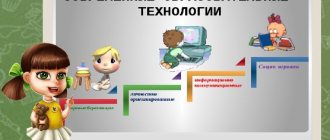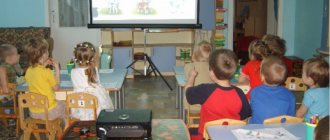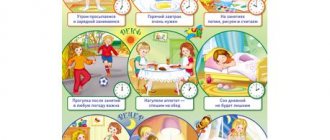Protocol for analysis of direct educational activities
Regional state budgetary professional educational institution
"NORILSK PEDAGOGICAL COLLEGE"
Specialty 02/44/01
"Preschool education"
PROTOCOL OF ANALYSIS OF NON-DIRECT EDUCATIONAL ACTIVITIES
Performed:
Baranova E. A
2020
Analysis of GCD for environmental education
| Educator | Kopkova Yu.D. | |||
| Age group | older | |||
| Lesson topic | "Houseplants" | |||
| Duration | 25 min | |||
| Dosage of carrying out time (parts of GCD) | Methods and techniques | Activities of the teacher | Children's activities | Notes |
| Part 1 - 5 min. Part 2 - 15 min. 3. part - 5 min. | Verbal, visual, practical. Demonstration, artistic expression, questions, etc. | Quality of explanation, Voice control and speech culture. | Attention, activity, perseverance and initiative during the implementation. Well-being and mood of children. | The teacher tried to monitor each child so that they did not pour water into the flowers, did not push, did not loosen them correctly, etc. |
| To what stage of the work on developing a humane attitude towards living nature do the program content tasks belong? | Cultivate a love for plants , a caring attitude and a desire to care for them. Be able to communicate with nature as with a living organism. | |||
| Assess the proper organization of the environment, the placement of objects, the placement of children; | The natural corner is located in such a way that all the material being studied is at the level of children's eyes. In the first part, the formation was circular, then in the second part, the children were distributed into subgroups. | |||
| Name the methods of attracting children's attention and arousing interest (surprise moments, riddles, setting a cognitive task, problem situation), their effectiveness; | Creation of a problem situation, visual material (plants), fertilizers harmless to children and tools (watering can, spatula, etc.). A conversation to attract children to the fact that if you do not water, fertilize and care for plants, they will die. | |||
| Assess the nature of the tasks and questions, the sequence of their presentation (logic of the lesson), and characterize the content of the children’s answers. | The lesson was divided into three parts. Every part was carefully constructed. Riddles about plants, viewing illustrations, practical part (watering, fertilizing, etc.) and final part (stories, questions). The children were very interested, so they willingly answered questions and gave detailed answers. | |||
| Explain the methods of including children in survey activities during observation, their nature, and effectiveness. | Monitoring development and growth plants in a corner of nature; examining stems and leaves of different | |||
| List and explain the advisability of using techniques for activating mental activity (search questions and actions, comparison, use of childhood experience, etc.). | Creating a problematic situation encourages children to take action, to sympathize, to empathize. Reading stories, riddles, questions - activate the mental activity of children. Comparative analyzes and questions: how does mom do it? Are you helping mom? What other plants do you have at home? etc. | |||
| Did the children show interest during the observation (emotions, questions, focus)? Support with examples. | Children actively participated in the lesson, asked questions, worried, and experienced emotional delight while caring for and observing plants. Many children have a strong desire to do this at home with their parents. | |||
| List the individual manifestations of children in the process of educational activities and the teacher’s individual approach to them. | The children independently tried to divide the roles: watering, wiping leaves, fertilizing, etc. The teacher correctly distributed the order of completing these tasks and, thus, each child received personal attention from the teacher. | |||
| Explain the peculiarity of the end of the GCD (the teacher's story, reading a work of art, children's stories, asking riddles, singing songs, setting for further study). Your opinion on the feasibility of such completion of the GCD. | Consolidate the lesson by reading short stories about plants by K. D. Ushinsky. Questions for children. I believe that such completion of the lesson will consolidate the acquired knowledge and serve as an incentive for children to apply it in practice. | |||
Conclusions:
During the observation of this educational activity, I came to the conclusion that it is not difficult to interest a child. It is important to find the right approach. Proper construction of the lesson will ensure the planned result. Children's practical activities encourage them to be independent, to work, and to want to do it all the time. Observing natural objects develops logical thinking, concentration, aesthetic taste, love and respect for all living things. Love of nature, skills of caring for it, give rise not only to interest in nature, but also contribute to the formation of the best character traits in children, such as: patriotism, hard work, humanity, respect for the work of adults who protect and increase natural resources.
Analysis of GCD
(formation of sound culture of speech)
| Performance evaluation criteria teacher in class | Positive moments | Recommendations | |
| Educator | Rogacheva O.E. | ||
| Age group | Older | ||
| Lesson topic | “Sound culture of speech. Sounds Ш, Ш» | ||
| Duration | 25 min. | ||
| Preparation for class | The ability to creatively use ready-made lesson notes (make necessary changes to the course of the lesson, adjust goals in accordance with the individual characteristics of children) | This summary was developed taking into account the age, mental and individual characteristics of children in this group. The teacher determined: goals, objectives and their content. Methods, techniques and tools necessary for positive results. | |
| The ability to draw up a lesson summary in accordance with the goals, determine its content and structure, and select didactic games | The lesson is methodically structured correctly, the topic and purpose are clearly visible. The specific tasks that were implemented throughout the lesson are highlighted. | ||
| selection of demonstration and handout material | A variety of bright illustrations, handouts for each child. The manuals are of sufficient size and aesthetically designed. | ||
| Rational placement of material | All material was positioned so that every child could see it. | ||
| Preliminary work with children (conversations, organization of observations, “homework” with the involvement of parents, reading fiction) | Pronunciation of pure sayings. reading fiction. | ||
| Sanitary and hygienic requirements | Satisfying children's motor activity (dynamic pauses, physical education sessions) | The types of activities changed gradually. Dynamic pause. Physical education minute. The children themselves took part in the game moments and were active helpers. | |
| Monitoring correct posture while working at a desk | I made comments and corrected them. She explained what could happen if you sit incorrectly. | ||
| Changing children's poses during class | The children's poses changed depending on the stages of the lesson. Conversation - sitting on chairs, moving around the group during dynamic breaks, physical education minutes. | ||
| Compliance of the duration of the lesson with sanitary and hygienic standards | The duration of the lesson is 25 minutes, which complies with SanPiN standards. | ||
| Pedagogical excellence | Using various forms of organizing children in the classroom (small subgroups, in pairs, individual and group work). Justification of the chosen forms. | The lesson was conducted with a subgroup of children. Individual assistance was provided only to children in need. The result was summed up after each part of the lesson, in the form of approval and praise. | |
| Gaming techniques | didactic exercises, showing the position of the organs of articulation when pronouncing sounds. | ||
| Techniques for attracting and focusing children’s attention (available or not) | Showing illustrations, mastering intonation and timbre of voice, asking questions to children. | ||
| Techniques to ensure children's emotionality and interest | Requests for children to “smile at each other”, “thank each other with applause”, etc. | ||
| Techniques for activating children's independent thinking. | Search questions, actions, comparisons, use of childhood experience. | ||
| Techniques for introducing new things based on children’s existing knowledge. | Improvisation, proposal writing. | ||
| The ability to regulate children’s behavior during the lesson, maintain interest during the lesson | Establishing a positive emotional background. The specifics of working with children in the classroom were reflected in a person-centered approach. She encouraged timid children and praised them in order to consolidate their situation of success. | ||
| The ability to adjust the course of the lesson taking into account the “feedback” (reduce the time of the lesson depending on the degree of fatigue of the children, change the form of organization of the children, move part of the program material outside the scope of the lesson, use a dynamic pause in a timely manner). | Timely use of dynamic pause and physical education minutes. | ||
| Individual work with children | 2-3 children pronounce tongue twisters with a given sound. | ||
| Assessment of work in class (by children, teacher), its quality | During the lesson, the teacher maintained a friendly tone and smile. She praised the children at every stage and encouraged the children to independently evaluate themselves and their comrades. | ||
| Children’s behavior during class (activity, maintaining interest, attention) | The children were active, trying to stand out and attract the teacher’s attention. The children remained motivated throughout the lesson. | ||
| Children's assimilation of program content | Children have mastered the given program | ||
Conclusions:
Analyzing the lesson, we can say that the assigned tasks were successfully completed. I believe that the lesson is structured logically, and the stages of the lesson are interconnected. The logical structure of the lesson made it possible to conduct it without going beyond the time allotted for completing the task. Thanks to the friendly attitude, competent speech and correct intonation of the teacher’s voice, the material was interesting to the children and would be easier to assimilate.
Analysis of GCD for introducing children to fiction
| Educator | Rogacheva O.E. | |||
| Age group | Older | |||
| Lesson topic | Reading the fairy tale “Sister Fox and the Wolf” | |||
| Duration | 25 min. | |||
| Dosage of carrying out time (parts of GCD) | Methods and techniques | Activities of the teacher | Children's activities | Notes |
| Part 1 - 5 min. Part 2 - 15 min. 3. part - 5 min. | Verbal: reading fiction, Visual: display, gaming, practical, staging. | Quality of explanation, Voice control and speech culture. | Practical, Game, distribution of roles. | The teacher encouraged the children to think in order to decide on the role that the child could try on. |
| What type of lesson was held? | ¾ Reading one work; Dramatization with musical accompaniment. | |||
| Do the objectives of the program content correspond to the solution of literary, educational problems and speech development of children? | Yes, they completely correspond. Several types of speech are developing: Connected, dialogue, sound culture of speech. A dictionary is being formed. | |||
| Construction of a lesson taking into account the peculiarities of preschoolers’ perception of literary works. | The lesson was structured in accordance with the age requirements of this group | |||
| The quality and aesthetics of visual aids, the appropriateness of their use in the classroom. | The books are in excellent condition, brightly illustrated, which contributes to the development of aesthetic taste. | |||
| Fulfillment of psychological and hygienic requirements for organizing classes. | The room was ventilated before class. We carried out hardening procedures and gymnastics after sleep. The teacher tried to take into account the individual capabilities of the children. | |||
| Rational use of time (duration of the entire lesson, its structural parts). | The lesson was structured logically. The structural parts met the program requirements. | |||
| Methodological techniques used for meaningful perception of the work and activation of children's speech. | The technique of imitative activity was used. Mimic gymnastics was carried out with the children, and emotions were clearly expressed when reading the work. | |||
| A combination of verbal methodological techniques with visual ones. | conversations after familiarization with the work, helping to determine the genre, the nature of the characters, the main content, and means of artistic expression. Using different types of staging. | |||
| Explanation of unfamiliar words | Substituting another word while reading, selecting synonyms; dialogue rhyme. | |||
| Methodological techniques aimed at memorizing a poem when memorizing: | Children's completion of a rhyming word; dramatization. | |||
| Techniques aimed at developing expressiveness of speech. | Example of expressive reading, example of expressive reading by a child; reading assessment; hint of the required intonation. | |||
| The structure of the lesson, the relationship of their individual parts, the role of each part. | The lesson was structured competently and logically, each part was structured based on its goals and objectives. | |||
| Did the lesson achieve the goals and objectives set by the program content? | Yes, it has. A positive - aesthetic attitude towards the work was formed. Learned to understand the meaning of the work; Children learned to describe characters; | |||
| Analyze the educational tasks set by the teacher. | The task was to cultivate moral qualities: respect, kindness, honesty, generosity. | |||
| To what extent have educational problems been solved? | Educational problems were completely solved. | |||
| Assessing the presentation of a work of art to children. | The teacher read the work emotionally, with expression, with logical emphasis and pauses. | |||
| Pedagogical culture of the teacher. | Tact in communicating with children, without raising your tone. Spelling-correct speech. | |||
| Appearance of the teacher in class | Neatness in dress and compliance with rules and regulations when working in a preschool institution. | |||
| The degree of speech activity and the level of performance of children in the classroom. They have an interest in the activity and skills for independent activity. | The children tried to communicate correctly and lexically during the performance. The dramatization revived them and they were interested in trying it themselves. They actively took part. | |||
| Level of development of the simplest skills of educational activities. | Average level of formation. | |||
Conclusions:
Children can hear and listen, but they lose interest and get tired quickly. But thanks to this lesson, I realized that strict logic is needed when constructing lessons, each lesson structure must be complete and interesting for children. If the child is interested, the lesson will go according to plan, and all problems will be completely solved.
Analysis of GCD
for mathematical development
| Performance evaluation criteria teacher in class | Positive moments | |
| Educator | Sheredkina O.S. | |
| Age group | older | |
| Lesson topic | "Gather a figure" | |
| Duration | 25 min | |
| Preparation for class | The ability to creatively use ready-made lesson notes (make necessary changes to the course of the lesson, adjust goals in accordance with the individual characteristics of children) | If the child was distracted or deviated from the topic, the teacher was able to engage him and turn the lesson in the right direction. |
| The ability to draw up a lesson summary in accordance with the goals, determine its content and structure, and select didactic games | The lesson is methodically structured correctly, the topic and purpose are clearly visible. Specific tasks that were implemented throughout the lesson are highlighted. | |
| selection of demonstration and handout material | Bright visual material, aesthetics of appearance interested and caught the eyes of children | |
| Rational placement of material | All material was positioned so that every child could see it. | |
| Preliminary work with children (conversations, organization of observations, “homework” with the involvement of parents, reading fiction) | Conversation, checking homework with parents, questions. | |
| Sanitary and hygienic requirements | Satisfying children's motor activity (dynamic pauses, physical education sessions) | Finger gymnastics, physical education. |
| Monitoring correct posture while working at a desk | She made comments, corrected, corrected. | |
| Changing children's poses during class | Depending on the structural parts of the lesson, the motor activity of the children was satisfied. | |
| Compliance of the duration of the lesson with sanitary and hygienic standards | The duration of the lesson is 25 minutes, which complies with SanPiN standards. And the program under which the preschool educational institution operates. | |
| Pedagogical excellence | Using various forms of organizing children in the classroom (small subgroups, in pairs, individual and group work). Justification of the chosen forms. | The lesson was conducted with a subgroup of children. This form is completely justified, since it is possible to pay individual attention to each child. |
| Gaming techniques | Using didactic exercises, physical education, finger gymnastics | |
| Techniques for attracting and focusing children’s attention (available or not) | A surprise moment, asking questions to stimulate children’s thinking | |
| Techniques to ensure children's emotionality and interest | Comparing each other's results, who is faster, etc. | |
| Techniques for activating children's independent thinking. | Search questions, actions, comparisons, use of childhood experience. | |
| Techniques for presenting something new, based on children’s existing knowledge. | Suggestions to children to invent or remember and make a logical connection with the given material themselves | |
| The ability to regulate children’s behavior during the lesson, maintain interest during the lesson | The teacher was able to switch attention in time and maintain interest. Using verbal and logical techniques | |
| The ability to adjust the course of the lesson taking into account the “feedback” (reduce the time of the lesson depending on the degree of fatigue of the children, change the form of organization of the children, move part of the program material outside the scope of the lesson, use a dynamic pause in a timely manner). | Timely use of didactic exercises, finger exercises and physical education as children get tired. | |
| Individual work with children | The teacher helped 2–3 children who needed help assemble the necessary shapes from sticks | |
| Assessment of work in class (by children, teacher), its quality | The teacher encouraged and praised the children. The intonation is calm, the tone is friendly. Children who found it difficult were asked to watch and evaluate the work of children who did well. | |
| Children’s behavior during class (activity, maintaining interest, attention) | The children were active, trying to stand out and attract the teacher’s attention. The children remained motivated throughout the lesson. | |
| Children's assimilation of program content | I think that the children learned this program content well | |
Conclusions:
Analyzing this lesson, I can say that it was interesting and well structured. The educational process smoothly moved from one structural part to another. To ensure that the children did not lose interest in the lesson, the teacher directed the practical part into a competitive direction; in conclusion, comparison and evaluation of their work and the work of their comrades also gave a positive result.
Analysis of GCD
for the development of coherent speech
| Performance evaluation criteria teacher in class | Positive moments | |
| Educator | Sheredkina O.S. | |
| Age group | Older | |
| Lesson topic | "Winter" | |
| Duration | 25 min. | |
| Preparation for class | Ability to creatively use ready-made lesson notes | Depending on the mood of the children, the teacher changed the intonation, encouraged, and praised. I made adjustments to goals, individually with 2-3 children. |
| The ability to draw up a lesson summary in accordance with the goals, determine its content and structure, and select didactic games | The structure of the GCD fully corresponded to the given topic; all parts were correctly distributed. The notes included breathing exercises and physical education. | |
| Selection of demonstration and handout materials | Audio recording, bright and colorful illustrations that attract attention. | |
| Rational placement of material | All material was positioned so that every child could see it. | |
| Preliminary work with children | Conversation, observations while walking, reading poems | |
| Sanitary and hygienic requirements | Satisfying children's motor activity (dynamic pauses, physical education sessions) | Physical education minutes, according to the notes |
| Monitoring correct posture while working at a desk | The furniture is selected according to the height of the children. The teacher paid attention to the child’s posture and if it was incorrect, asked to change it. Followed the motor regimen. | |
| Changing children's poses during class | The children moved, depending on the parts of the lesson (sitting, standing, moving). | |
| Compliance of the duration of the lesson with sanitary and hygienic standards | The duration of the lesson is 25 minutes, which complies with SanPiN standards. | |
| Pedagogical excellence | Using various forms of organizing children in the classroom | Group form of training organization (individual-collective). First of all, it is important for the teacher to ensure the interaction of children in the learning process. |
| Gaming techniques | Creating a game situation, solving riddles. | |
| Techniques for attracting and focusing children’s attention (available or not) | Intonation and timbre of the voice, emotionality of expressions. Bright illustrated pictures. Praise | |
| Techniques to ensure children's emotionality and interest | Attracting to the game, encouraging, smiling. | |
| Techniques for activating children's independent thinking. | Questions, discussions, small folklore forms. | |
| Techniques for introducing new things based on children’s existing knowledge. | Story plan, retelling in pairs. | |
| The ability to regulate children’s behavior during the lesson, maintain interest during the lesson | The specifics of working with children in the classroom were reflected in a person-centered approach. She encouraged timid children and praised them in order to consolidate their situation of success. | |
| The ability to adjust the course of a lesson taking into account “feedback” | Correctly composed parts of the GCD made it possible to use physical education minutes in a timely manner | |
| Individual work with children | When difficulties arose, the teacher helped Denis and Georgy individually. | |
| Assessment of work in class (by children, teacher), its quality | The teacher encouraged and encouraged the children who found it difficult, and offered to watch and evaluate the work of the children who did well. | |
| Children’s behavior during class (activity, maintaining interest, attention) | The children were interested, answered questions animatedly, and tried to choose expressive epithets | |
| Children's assimilation of program content | Children have mastered the given program | |
Conclusion:
The tasks set by the teacher corresponded to the level of development of the children and program requirements. The children mastered the program content of the lesson well, were attentive, interested and active. The methods and techniques used helped to fully solve each of the tasks.
Analysis of GCD for environmental education
Cognitive and research experimental activities
| Educator | Kopkova Yu.D. | |||
| Age group | Older | |||
| Lesson topic | "Sinks - floats" | |||
| Duration | 25 min. | |||
| Dosage of carrying out time (parts of GCD) | Methods and techniques | Activities of the teacher | Children's activities | Notes |
| Part 1 - 5 min. Part 2 - 15 min. 3. part - 5 min. | Verbal, visual, practical. Demonstration, artistic expression, questions, etc. | Preliminary work, riddles, questions, reading poems. | Attention, activity, perseverance and initiative during the implementation. | The teacher monitored the process, guided, and explained. |
| To what stage of the work on developing a humane attitude towards living nature do the program content tasks belong? | Cultivate observation and interest in the world around you. Foster a humane attitude towards nature. To give children an understanding of the world around them through familiarization with basic knowledge about the properties of objects. | |||
| Assess the proper organization of the environment, the placement of objects, the placement of children; | The lesson was conducted by a subgroup of 9 people. The materials were arranged so that each child could interact with them and see them. | |||
| Name the methods of attracting children's attention and arousing interest, their effectiveness; | Riddles, setting cognitive tasks. Involving children to conduct an experiment themselves under the guidance of a teacher is an effective method for stimulating interest. | |||
| Assess the nature of the tasks and questions, the sequence of their presentation (logic of the lesson), and characterize the content of the children’s answers. | The lesson consisted of three structural parts. Every part was carefully constructed. Riddles, questions for children, a practical part (the experiment itself) and a final part (questions, analysis of children's impressions). The children were very interested, so they willingly answered questions and gave detailed answers. | |||
| Explain the methods of including children in survey activities during observation, their nature, and effectiveness. | Each child took a direct part in the experiment, and the children had the opportunity to observe and draw conclusions themselves. | |||
| List and explain the advisability of using techniques to enhance mental activity | Problem situation, conversation, experiment. Through sympathy, the desire to help, to be useful, to learn new things, all this contributes to the activation of mental activity, because the child himself tries to find a way out of the current situation. | |||
| Did the children show interest during the observation (emotions, questions, focus)? Support with examples. | During the experiment, the children vying with each other asked questions, they experienced an emotional upsurge, they wanted to share their impressions with their family, and involve them in similar experiments at home. | |||
| List the individual manifestations of children in the process of educational activities and the teacher’s individual approach to them. | Each child, under the supervision of a teacher, was able to independently analyze the effectiveness of the experiment. The activation of children's thinking during the experiment was at a high level. The teacher prompted and guided the struggling child. | |||
| Explain the peculiarity of the end of the GCD (the teacher's story, reading a work of art, children's stories, asking riddles, singing songs, setting for further study). Your opinion on the feasibility of such completion of the GCD. | In the third structural part, the teacher consolidated the material through reflection (leading questions, children's stories). | |||
Conclusion:
In the course of observing educational and research experimental activities, I came to the conclusion that it is not difficult to attract the attention of children. It is important to be able to maintain this attention, which is what I observed during this analysis. Competent construction of the lesson ensured the planned result. Children's practical activities encourage them to be independent, to work, and to want to do it all the time. Conducting experiments independently, observing the subjects of experimentation, evokes an emotional response in them and concentration of attention. Children strive to learn more about the world around them, about objects, interaction with which causes them delight and a storm of emotions.
Protocols on labor protection in preschool educational institutions
Along with the acts, labor safety protocols are filled out in the preschool educational institution, and messages and notifications on labor safety of various kinds are drawn up and transmitted, especially a message about an accident that occurred with a kindergarten student and a production worker (Form 8). It is necessary to take a responsible approach to drawing up a protocol and occupational safety notice about a group accident and a fatality in a preschool educational institution, and draw up a protocol for examining the accident site.
download: Acts and Protocols on labor protection in preschool educational institutions 37 acts and protocols for kindergarten. Update November 12, 2022
- Act N-1 of the investigation of an industrial accident
- Act of investigation of a group and fatal accident
- Occupational Disease Case Report
- Act of conducting an official investigation
- Protocol of interviewing the victim and eyewitness of the accident
- Protocol for inspection of the accident site, form 7
- Reporting an accident at work (form

- Report on an accident with a preschool student
- Act on the investigation of a group (fatal) accident with a pupil
- Protocol for inspection of the accident site at the preschool educational institution
- Protocol for interviewing an eyewitness to an accident at a preschool educational institution
- Reporting an accident to a preschool educational institution
- Notification of a group fatality accident







